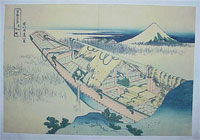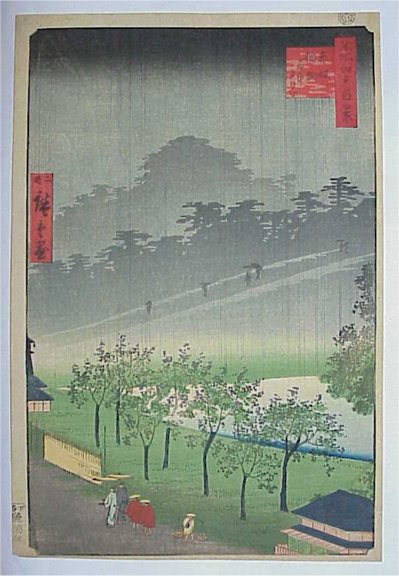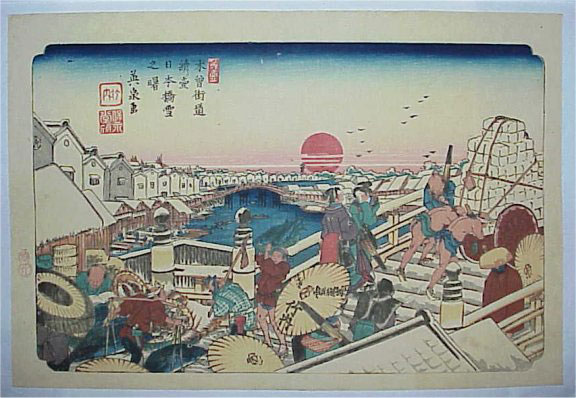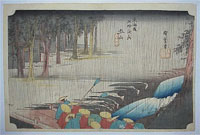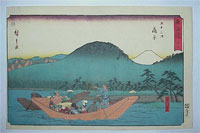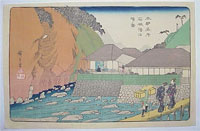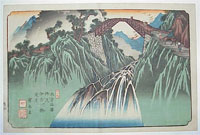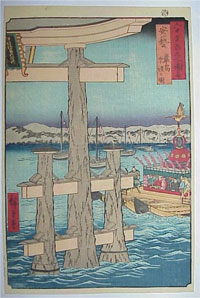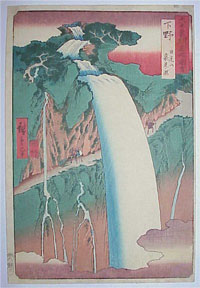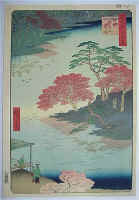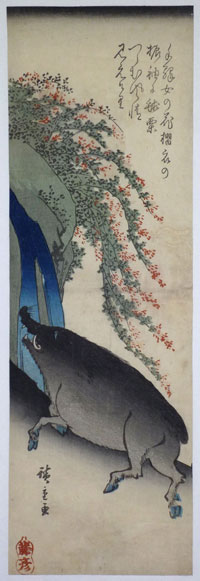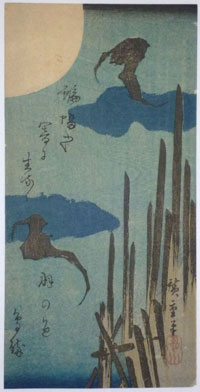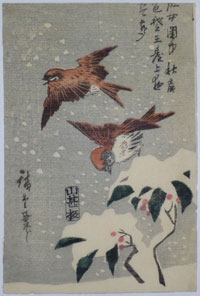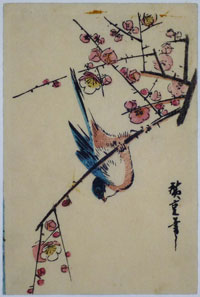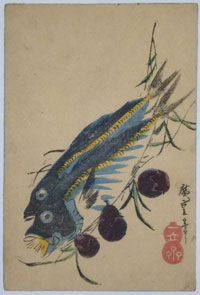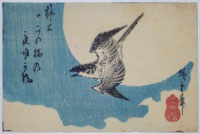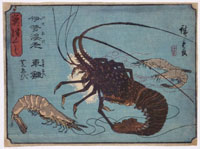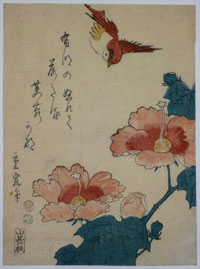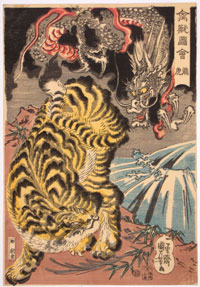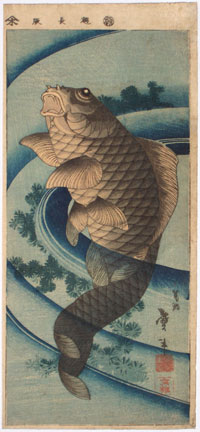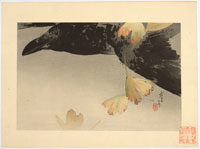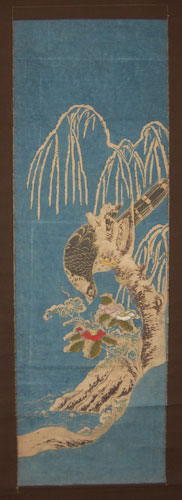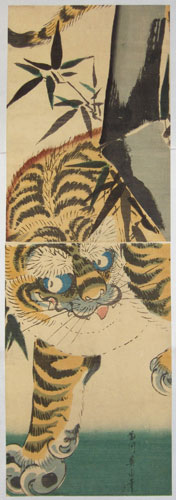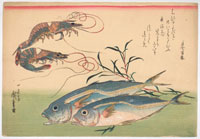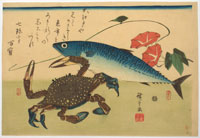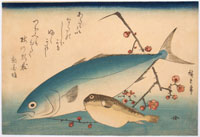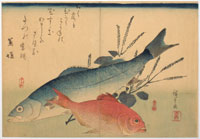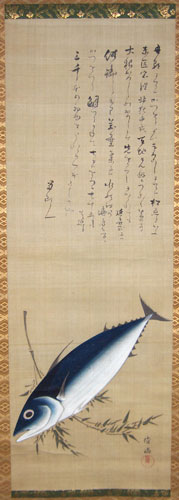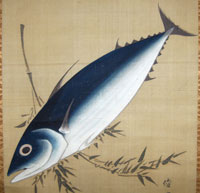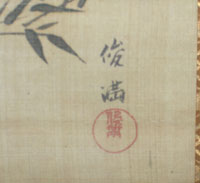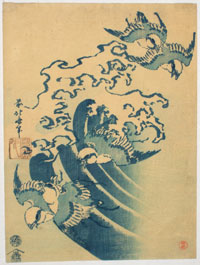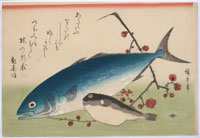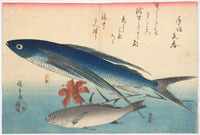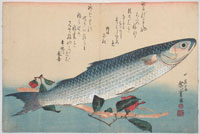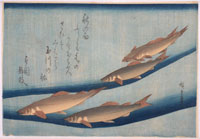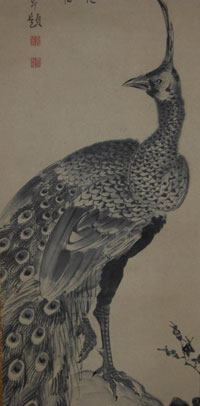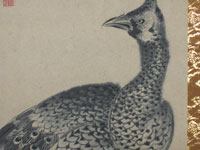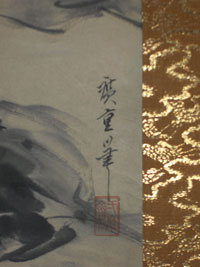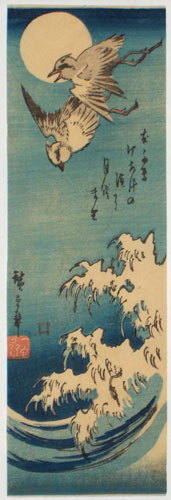/category/archive/page/40/
Katsushika HOKUSAI (1760-1849)
Click here to view image full size.
Joshu Ushibori from Fugaku sanju-rokkei, the “Thirty-Six views of Mount Fuji”. The set published by Eijudo c1829-33. Probably the most difficult design from the set to find in early impression. (There exist first printings entirely in blue, but they are extremely rare.)
Very good early impression (blue outline) with very good colour. Slight centre fold, otherwise very good condition. Signed Zen Hokusai Iitsu ga
Status: Sold
Ichiyusai HIROSHIGE II (1826-1869)
Click here to view image full size.
A rainy evening. Akasaka, Kiribataka. The substitute print for design 48 by Hiroshige I from “The One Hundred Views of Edo” published by Uoei between 1856 and 1859 (this being Sheep 6, 1859). A lovely design and superior to the print it replaced.
Very good impression, colour and condition. Signed “The second” Hiroshige ga.
Status: Sold
Keisai EISEN (1790-1848)
Click here to view image full size.
Early morning snow on Nihonbashi. The first design from Kisokaido rokujukyu-tsugi, “The Sixty-Nine Stations of the Kiso Highway” published c1836 by Takeuchi and Hoeido. The extremely rare first edition with rising sun, publisher’s name on umbrella and signature: There are at least three later states of this design.
Superb impression and colour. One very small backed wormhole, otherwise very fine condition with extra large margins and complete seal at left. Signed Eisen ga.
Status: Sold
Ichiryusai HIROSHIGE (1797-1858)
Click here to view image full size.
Beauties and snow on the Sumida River. The winter scene from a set of four triptychs of famous places in the four seasons. Published by Marujin, 1848-49. Considered to be Hiroshige’s finest design in this genre. Illustrated on covers of Eight Hundred Years Of Japanese Printmaking, Museum Of Art Carnegie Institute, 1977.
Very good impression with perfect colour, Full size and matching. Original backing sheets, Fine condition. Signed Hiroshige ga. (There were some cracks in the blocks for this design and they appear on every known impression.)
Status: Sold
Ichiryusai HIROSHIGE (1797-1858)
Click here to view image full size.
Tsuchiyama from The Fifty-Three Stations of the Tokaido. The set published 1833-34 by Takenouchi Magohachi and Tsuruya Kiemon, Shows a daimyo’s procession crossing a stream in heavy rain.
Very good early impression. Very good colour, Small paper flaw near left edge otherwise very good condition,. Signed Hiroshige ga
Status: Sold
Ichiryusai HIROSHIGE (1797-1858)
Click here to view image full size.
Kambara, Station 16, from The Fifty-Three Stations of the Tokaido, generally known as the Reisho Tokaido. Published c1850-51 by Maruya Seijiro.
Extremely fine first edition with the deluxe red pigment in cartouche. Fine colour and condition with extra paper on right for publisher’s seal. Signed Hiroshige ga.
Status: Sold
Ichiryusai HIROSHIGE (1797-1858)
Click here to view image full size.
Hakone tochiba no zue, “Hakone Spa” from the set Honcho Meisho, “Views of Our Homeland”. An excessively rare set published by Fujihiko, c mid 1830s. I have never noted another impression of this design for sale. The complete set, which contains some of Hiroshige’s rarest masterpieces, is illustrated in Utagawa Hiroshige, Juzo Suzuki, nos 438 – 452.
Fine impression, colour and condition. Signed Hiroshige ga.
Status: Sold
Keisai EISEN (1790-1848)
Click here to view image full size.
The Ina River Bridge, Nojiri from the series Kisokaido rokujukyu-tsugi, “The Sixty-Nine Stations of the Kiso Highway”, published c.1836 by Takeuchi and Hoeido. Extremely rare first state of first edition of this fine design: Only the earliest edition has the geese above and beneath the bridge, the extra peaks in the same area and to the far top left. Also the signature is only found on earliest state. See Lane, Images from the Floating World, no.194 (A-B), p.190.
Very good impression and colour. Very slight centrefold otherwise good condition. Signed Keisai ga.
Status: Sold
Ichiryusai HIROSHIGE (1797-1858)
Click here to view image full size.
Aki, Itsukushima Sairei-no zu. Aki is the old name for Hiroshima. The beautiful Torii of Itsukushima Shrine at Miyajima is considered to be one of the three best views in Japan. Published Ox12 (1853) by Koshimuraya Heisuke from the Famous Places in the Sixty-Odd Provinces.
Fine, very early impression. Fine coloured and condition. Signed Hiroshige ga.
Status: Sold
Ichiryusai HIROSHIGE (1797-1858)
Click here to view image full size.
The Urami Falls, Mt. Nikko, Shimotsuke Province, Shimotsuke, Nikkosan Urami no taki from the Famous Places in the Sixty-Odd Provinces. Published Ox 8 (1853) by Koshimuraya Heisuke.
Fine, very early impression but not the earliest of all (see Pulverer impression). However, this is one of those cases where the earliest is not the preferred state: The Pulverer copy has the waterfall printed solid blue whereas this impression has the water blind-printed and the gradation on the side making for a more beautiful composition. Fine colour. Minor soil, otherwise very good condition. Signed Hiroshige ga.
Status: Sold
Ichiryusai HIROSHIGE (1797-1858)
Click here to view image full size.
The temple compound if the Akiba Shrine, Ukiji, Ukiji Akiba no keidai, from The Hundred Views of Famous Spots in Edo. Published Snake 8 (1857) by Uoya Eikichi.
Fine impression and colour. Minor mark au verso left margin, otherwise fine condition. This is the earliest edition with the break in the character “eight” in the date seal top margin. The figure sketching on the verandah, bottom left, is supposed to be Hiroshige. Signed Hiroshige ga.
Status: Sold
Utagawa HIROSHIGE (1797-1858)
Click here to view image full size.
A chu-tanzaku showing a wild boar beside a waterfall. This was probably designed for a set of twelve zodiacal signs set. Other known prints from this group are: Ox, Dog, Hare, Tiger, Monkey and Horse. All are extremely rare. Indeed, I cannot locate another impression of this print. Published c 1830 by Fujihiro.
Fine impression. Restored wormhole centre right and slight centre fold. Otherwise good condition. Signed Hiroshige ga.
Status: Sold
Utagawa HIROSHIGE (1797-1858)
Click here to view image full size.
Evening with full moon and bats flying over irregular wood stacked in a timberyard. A well known print. One third block, 9.75 x 5 in; 25 x 12.5 cms. The only complete uncut example seems to be that illustrated in Four Hundred Ukiyoe Woodblock Prints From The Museum Of Art, Rhode Island School Of Design, 1990, no. 167, which shows the companion prints to be butterflies and wild grasses and tuna and white radish. Hiroshige designed another bat print, otherwise it?s a rare subject for ukiyoe. Ex collection Paul-Louis de la Noe, 1879-1919, ( an acquaintance of the Goncourt brothers, Bing and Hayashi ). Published c late 1830s.
Fine impression. Very good colour and condition. Signed Hiroshige hitsu.
Status: Sold
Utagawa HIROSHIGE II ( SHIGENOBU ) (1826-1869)
Click here to view image full size.
A quarter-block, 6.5 x 4.25 in; 16.5 x 11 cms, print showing two tree sparrows flying in snow over snow-covered bushes. Published by Yamashiroya Kambei (?) c late 1840s. Ex collection Paul-Louis de la Noe, 1879-1919, ( an acquaintance of the Goncourt brothers, Bing and Hayashi ). Possibly unique.
Very good impression, colour and condition. Signed Hiroshige hitsu.
Status: Sold
Utagawa HIROSHIGE (1797-1858)
Click here to view image full size.
A quarter-block, 6.5 x 4.25 in; 16.5 x 11 cms, print showing a titmouse perched on a cherry blossom branch. Published c late 1830s. Ex collection Paul-Louis de la Noe, 1879-1919, ( an acquaintance of the Goncourt brothers, Bing and Hayashi ). Probably unique.
Very good impression, colour and condition. Signed Hiroshige hitsu.
Status: Sold
Utagawa HIROSHIGE (1797-1858)
Click here to view image full size.
A quarter-block, 6.5 x 4.25 in; 16.5 x 11 cms, print showing two horse-mackerel and baby aubergines. Published c late 1830s. Ex collection Paul-Louis de la Noe, 1879-1919, ( an acquaintance of the Goncourt brothers, Bing and Hayashi ). Probably unique.
Very good impression, colour and condition. Signed Hiroshige hitsu.
Status: Sold
Utagawa HIROSHIGE (1797-1858)
Click here to view image full size.
A quarter-block, 4.25 x 6.5 in; 11 x 16.5 cms, print showing a cuckoo flying against a full moon. This bird is usually associated with the moon and is a harbinger of spring. Published late 1830s. Ex collection Paul-Louis de la Noe, 1879-1919, ( an acquaintance of the Goncourt brothers, Bing and Hayashi ). Probably unique.
Very good impression, colour and condition. Signed Hiroshige hitsu.
Status: Sold
Utagawa HIROSHIGE (1797-1858)
Click here to view image full size.
Sakana zukushi, A Fish Series, this design showing Ise-ebi, Kuruma-ebi and Shima-ebi, Lobster [ with roe ], Prawn and Shrimp. A half-block set of the utmost rarity. Indeed, this might be the only recorded example. One other design from the same set is illustrated in Hiroshige, The Albuquerque Museum, 1983, no. 327. Published c late 1830s. Ex collection Paul-Louis de la Noe, 1879-1919, ( an acquaintance of the Goncourt brothers, Bing and Hayashi ).
Fine impression and colour. Slight edge soil with small repairs to to top left and right corners, otherwise very good condition. Signed Hiroshige ga.
Status: Sold
Utagawa HIROSHIGE II ( SHIGENOBU ) (1826-1869)
Click here to view image full size.
A half block, 8.5 x 6.5 in; 22 x 16 cms, print showing a tree sparrow and hibiscus. From a series of prints by the same publisher, Yamashiroya Kambei (?) published 1851-53 ( Kunugasa and Murata seals ). Probably Hiroshige IIs best set in this genre. Ex collection Paul-Louis de la Noe, 1879-1919, ( an acquaintance of the Goncourt brothers, Bing and Hayashi ).
Very good impression and colour. Very minor soil. Signed Shigenobu hitsu.
Status: Sold
Isoda KORYUSAI (1735-1790)
Click here to view image full size.
An hashira-e showing nine cranes, a pine tree and the rising sun. A triple talisman of good luck. The tancho ( “red crest” ) Japanese Crane, Grus japonensis, is the second rarest crane in the world, migrating to East Asia in the fall to spend the winter. There is also a resident flock in Hokkaido. Much loved by the Japanese, the crane was a symbol of luck, longevity and fidelity. Rare: Another impression is illustrated in Jacob Pins, The Japanese Pillar Print, V & A, 1982, no. 518 ( which is also illustrated in the V & A Museum catalogue, The Floating World Japanese Popular Prints 1700-1900, 1973, no. IV8 ). Published c. 1770. Koryusai was probably the most prolific designer of pillar prints, although he designed few kacho-e. Ex collection Seisuke Ikeda, 11 -12th April, 1910.
Very good impression. Good colour. Slight fold marks ( as usual ) but generally good condition for a pillar print. Signed Koryusai ga.
Status: Sold

Click here to view image full size.
Utagawa KUNIYOSHI (1797-1861)
Click here to view image full size.
A tiger and dragon from a rare series Kinju zue, “Drawings of Birds and Beasts.” The set of at least five prints published by Joshuya Kinzo, 1837. Although rare, there are different states of the prints from this set, some having yellow cartouches, others red and uncoloured ( as here ). This design is also known with other colour variations.
Very good impression, colour and condition. Signed Ichiyusai Kuniyoshi ga.
Status: Sold
Katsushika TAITO II (act. c. 1810-1853)
Click here to view image full size.
A carp swimming upwards amongst water plants. Taito designed a number of prints, of which this is one, with an ishizuri-e panel at the left. This is normally cut off ( as here ) and certainly adds nothing to the composition. This design must have been popular as there are a number of different states with different blocks for the water: As here and V & I, Estampes Japonaises, Tomes IV, VI, 1973, pl. LXIX, p. 222; Eight Hundred Years of Japanese Printmaking, Carnegie Institute, 1977, no. 346, p. 87 ( with ishizuri panel ), and there is a copy from completely new blocks. Published by Echigoya Chohachi, c. 1848.
Very good impression and colour. Minor soil. Signed Katsushika Taito fude.
Status: Sold
Watanabe SEITEI ( SHOTEI ) (1851-1918)
Click here to view image full size.
A crow in flight with falling ginko leaves from a set of 22 prints Nijuni kacho published 1916 by Okuro Yasugoro. This being the best design from the set.
Fine impression, colour and condition. These prints were published on heavy paper and the early printings must have the large seal bottom right corner. Signed Seitei.
Status: Sold
Kakemono-e ISHIZURI-E (c. late 18th century)
Click here to view image full size.
A falcon perched on a tree trunk above flowering camellias and a stream. These kakemono-e lie somewhere between prints and paintings. The actual technique employed seems to have involved pressing dampened paper into engraved wood. The pigment is then applied to the raised areas; the print then being laid onto thicker paper and pressed home giving a crinckley surface. They have traditionally been ascribed to Koryusai although examples are known with other signatures. Another example of this design was in the Vever collection, Sothebys, Part 1, 26/3/1974, no. 88, p. 69 where Jack Hillier states: ?The kakemono-e are however extraordinary technical and artistic creations, and the present specimen is one of the finest of the designs, comparable to the famous ?White Falcon? in the AIC ( Harunobu, etc., No. 181, p. 271 ).? ( That example appears to have been badly cut at the bottom. ) 35.5 x 11.5 inches, 90 x 29 cms. Mounted as a painting with rollers and box. Excessively rare.
Status: Sold
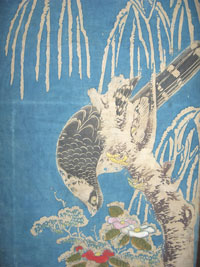
Click here to view image full size.
Kikugawa EIZAN (1787-1867)
Click here to view image full size.
A kakemono-e ( vertical diptych ) showing a tiger peering round a giant bamboo. Although Toyohiro and Toyokuni I produced kakemono-e during the 1800-1804 period, Eizan is generally identified with the format and published many during 1804-1817. The style used borrows from Korean paintings of tigers. No publisher’s seal, c.1804-1817. Another impression illustrated in Ukiyo-e no bi, nishiki-e no keifu, Yamaguchi Prefecture Municipal Museum, n.d., p.84/85.
Good impression. Very good colour and condition with the sheets separated to join accurately. Signed Kikukawa Eizan hitsu.
Status: Sold
Ichiryusai HIROSHIGE (1797-1858)
Click here to view image full size.
Aji, horse-mackerel ( Caranx trachurus ) and kuruma-ebi, prawns, from the first series of fish published by Eijudo, c.mid 1830’s ( although this design always lacks publisher’s seal ). Poem by Toshinoya Tomiharu.
Very good impression. Fine colour. One small thinned area, otherwise exceptional condition with extra paper all round. Signed Ichryusai Hiroshige ga.
Status: Sold
Ichiryusai HIROSHIGE (1797-1858)
Click here to view image full size.
Kani, crab, Charybois and saba, mackerel ( Scomber Japonicus ) together with morning glory. From the second series of fish published by Yamasho, c.1840-42. No publisher’s seal although later editions have the seal of Marujin who presumably bought the blocks and republished the set. Poem by Shichichintei Mampo.
Fine impression of the first edition. Fine colour. Small mark, otherwise fine impression. Full size with extra paper all round. Provenance: Ex Hayashi, Vever and Pulverer collections; the latter seal au verso. Signed Hiroshige ga.
Status: Sold
Ichiryusai HIROSHIGE (1797-1858)
Click here to view image full size.
Inada, yellow tail or amberjack ( Seriola quinqueradiata ) and fugu, blow fish or puffer ( Fugu pardalis ) with plum blossom from the second series of fish published by Yamasho, c.1840-42. Poem by Suzugaki. The number of late impressions and facsimiles of the two fish sets proves that the series was very popular at the time.
Fine impression of the rare first edition ( blue band at top; undamaged Yamasho seal, and block defect not printing ). Very good colour. Small repaired wormhole, otherwise very good condition. Signed Hiroshige hitsu.
Status: Sold
Ichiryusai HIROSHIGE (1797-1858)
Click here to view image full size.
Suzuki, Japanese sea perch ( Lateolabrax japonicus ) and kaneme-tai, red bream ( possibly Beryx splendens ), together with shiso or beefsteak plant. From the second series of fish published by Yamasho, c.1840-42. Poem by Atsugaki.
Very good impression ( with Ichiryusai seal but cross-hatching on the Suzuki; so a new state between Kruml 20a and 20b, Andon 49 ). Fine colour. Album backing and centre fold ( as per usual ). Signed Hiroshige ga.
Status: Sold
Kubo SHUNMAN (1757-1820)
Click here to view image full size.
An original painting of a bonito and a branch of bamboo. The bonito, called katsuo in Japan, was also called ocean bonito, strip-bellied bonito and striped tuna. It was, and is, highly regarded in Japan where it is smoked and dried to make katsuobushi, an important ingredient in making dashi ( Japanese fish stock ). The first bonito of the year were always highly anticipated. Shunman – an artist of great refinement – is famous for his exquisite surimono. Sumi and colour on silk with mica added to the eye and belly. Minor creasing and loss of gofun, otherwise good condition. Mounted with box. 90 x 31 cms; 35.5 x 12.25 inches ( image size ). Signed and sealed Shunman.
Status: Sold
Katsushika HOKUSAI (1760-1849)
Click here to view image full size.
Plovers and waves from a very rare set of ten half block aizuri prints published by Moriya Jihei, c. 1831. This design – and a few others from the set – never seem to come onto the market. There appear to be at least four other impressions known: The Victoria & Albert Museum impression is illustrated full page colour in Nelly Delay, L’Estampe Japonaise, Hazan, 1993, p. 195. ( It is also used in other publications. ) These designs were printed two-to-a-sheet. Ex Hayashi collection, seal bottom right.
Very good impression and colour. Minor browning and small spots, but otherwise very good condition. Signed Zen Hokusai no fude.
Status: Sold
Ichiryusai HIROSHIGE (1797-1858)
Click here to view image full size.
Inada, yellow tail or amberjack ( Seriola quinqueradiata ) and fugu, blow fish or puffer ( Fugu pardalis ) with plum blossom from the second series of fish. Published by Yamasho, c. 1840-42. The number of late impressions and facsimiles proves that the series was very popular at the time.
Fine, very early impression: Although it has the partly damaged Yamasho seal, the block defect beneath the fugu is still hardly visible and I think this is still the first edition issued as separate sheets by Yamasho and before the sets were bound. Very fine colour and condition with extensive mica on the Inada. Completely untrimmed. Signed Hiroshige hitsu.
Status: Sold
Ichiryusai HIROSHIGE (1797-1858)
Click here to view image full size.
Tobiuo, flying fish ( probably Prognichthys ) and ishimochi, also called guchi or shiroguchi, white croaker ( probably Argyrosomus argenatus ) together with a single lily from the second series of fish published by Yamasho, c. 1840 – 42. The number of late impressions and facsimiles proves that the series was very popular at the time.
Very good early impression with mica. Fine colour. Light album backing and slight centre fold ( as per usual ). Signed Hiroshige ga.
Status: Sold
Ichiryusai HIROSHIGE (1797-1858)
Click here to view image full size.
Bora, the grey mullet ( Mugil cephalus ) with camellia and Japanese asparagusudo from the first series of fish published by Eijudo, c. mid 1830’s. The number of late impressions and facsimiles proves that the series was very popular at the time.
Very good impression with extensive mica. Fine colour. Light album backing and slight centre fold (as per usual ). Signed Hiroshige ga.
Status: Sold
Ichiryusai HIROSHIGE (1797-1858)
Click here to view image full size.
Ai, or ayu, river trout ( Plecoglossus altivelis ) from the first series of fish published by Eijudo, c. 1832. The first design to be commissioned and considered the finest composition from the two sets. The number of late impressions and facsimiles proves that the series was very popular at the time.
Fine early impression with strong woodgrain. Examples before the Eijudo and kiwame seals ( as here ) are extremely rare. Fine colour. Completely full size with extra paper all round. Small repaired wormhole, otherwise very good condition. Signed Hiroshige hitsu.
Status: Sold
Ichiryusai HIROSHIGE (1797-1858)
Click here to view image full size.
An important and rare original painting of a peacock ( Pavo cristatus ) perched on a rock with peony blossom ( Paeonia suffructiosa ). The regal peacock is usually shown with peonies, symbols of opulence and associated with summer. The subject and style borrows from the Chinese-derived Kano style, but with a spontaneous wet brush. The peony is the floral symbol of China and the peacock ( male peafowl ) was kept by the Chinese for centuries. It was a popular subject for Japanese artists of all schools and frequently used to demonstrate their dexterity, giving rise to often highly finished paintings. Hiroshige, as usual in his paintings, eschews this for a simpler approach. Hiroshige designed at least four prints of the same subject: An o-tanzaku published by Jakurindo, c. 1832; a chu-tanzaku with no publisher, c. 1832; a chu-tanzaku published by Marujin, c. early 1840s; and a kakemono-e published c. early 1840s. The style of signature on this painting dates it to c. 1832 – the best period for his kacho prints. Although I have had, and seen, a number of kacho hanshita-e, this is the first such painting I have catalogued. A Chinese-style poem top left. The painting is illustrated in the bicentennial exhibition of Hiroshige’s birth, The World of Hiroshige, 1996 – 1997, Mainichi Shimbunsha, no. 307; Ukiyo-e Painters and their Works, Volume 1, Yoshida Teruji, 1963, Ryokuen Shobo and was exhibited at the National Diet Library supervised by Dr Suzuki Shigezo, n.d. The inside of the box is guaranteed by Dr Narazaki Muneshige. Sumi on paper, mounted with box; image size 50 x 9.5 inches, 127 x 24 cms. Signed Hiroshige hitsu with Ichiryusai seal.
Status: Sold
Ichiryusai HIROSHIGE (1797-1858)
Click here to view image full size.
Chidori, “plovers” flying against a full moon over breaking waves. This chu-tanzaku is one of Hiroshige’s best known kacho-e, and seems to have been highly regarded at the time as there are at least three other variants: One version, also published by Sanoki, is illustrated in Japanese Prints, James A Michener, Charles E Tuttle & Co, 1959, no. 226 ( with another impression in Tamba, The Art of Hiroshige, no. 411 ); another, without publisher, is illustrated in Sotheby’s sale catalogue 25/1/1978, lot 117; and a third, also without publisher and lacking moon, is illustrated in Hiroshige, Birds and Flowers, George Braziller, 1988, no. 32. It’s quite possible that the latter two are, in fact, contemporary copies. ( A problem that seems to have existed from Masanobu through to Yoshitoshi. )
Very good impression, colour and condition. Signed Hiroshige hitsu.
Status: Sold
Ichiryusai HIROSHIGE (1797-1858)
Click here to view image full size.
A chu-tanzaku of a small brown owl sitting on a pine branch, seemingly perched on the ‘prow’ of the three-day-old moon. ( To the Japanese the moon was at it’s most beautiful at this time. ) Generally considered to be one of the finest kacho prints by Hiroshige. Published c. mid 1830s.
Fine impression of the first edition with strong woodgrain showing. Later editions lack the gradation around the moon and a break appears in the kakihan beneath poem. Fine colour. Slight centre fold and trimming, otherwise very good condition. Signed Hiroshige hitsu.
Status: Sold
Ichiryusai HIROSHIGE (1797-1858)
Click here to view image full size.
Three cranes ( symbols of longevity ), new year firs and a large setting sun. Probably issued at the new year between 1847-1852. The title: Seimeiryu taitsu jyubun no koto and the inscription explain the Yakudoshi or unlucky years which occur every seven years. Published by Joshuya Kinzo. Extremely rare: I cannot locate another illustrated impression at moment.
Fine impression and colour. Small edge restoration, otherwise very good condition. Signed Hiroshige fude.
Status: Sold
Isoda KORYUSAI (Fl. c 1764-1788)
Click here to view image full size.
A dragon emerging from a muddy mire. Presumably a depiction of the dragon brought forth by Chinnan to produce rain in the parched village of Sogo. Koryusai copied a drawing or painting by Ganki ( top right inscription reads: ‘Painted by Ganki’ ). Extremely rare. I cannot locate another impression at present.
Very good impression. Colour applied by hand: Sumi; green ( on fangs ); gofun ( on claws ). Sumi also scraped or brushed on to simulate sprayed mud. One or two repaired wormholes and signs of mounting au verso, otherwise very good condition. Signed Hokyo Koryusai sha ( ‘Copied by Koryusai’ ).
Status: Sold
